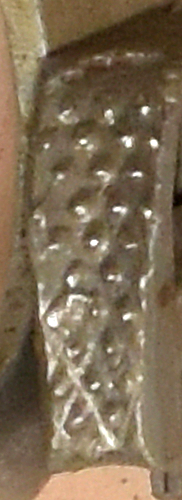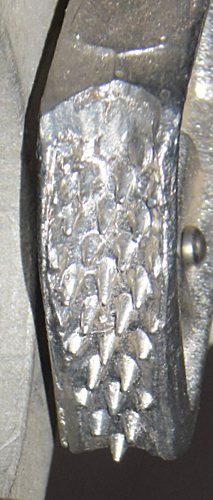Overview
[ Top
| Version B
| Return to H.E.C. Ascenders
]
Version A
(#3640)
Technical Details
I acquired this Interalp from Artyom Babin (Артём Бабин) in 2024.
This ascender is 198 mm. tall, 92 mm. wide,
30 mm. thick, and weighs 225 g.
 The shell is a tall irregular shaped stamping made from 3.58 mm.
aluminum alloy sheet metal. A 17 mm. diameter rope channel
is formed in the upper portion of one side and a smaller cam channel
lies opposite. A hole drilled through both sides of the cam channel
accepts a 6 mm. semi-tubular rivet. The cam and cam spring are mounted
on this rivet. The cam axle is centered 46mm. from the inside of the rope channel. The handle below the cam has a two-piece hard black
plastic hand grip riveted into place. The hand grip has four finger
grooves. A 15.9 mm. sling attachment hole lies below the
handle opening. This hole is not beveled. A 15.7 mm. hole passes through both sides of the rope
channel, providing an attachment point just above the cam. This
hole is not beveled either, and a carabiner placed in this hole
will probably drag on the rope. A similar hole lies just outside the rope channel.
The shell is a tall irregular shaped stamping made from 3.58 mm.
aluminum alloy sheet metal. A 17 mm. diameter rope channel
is formed in the upper portion of one side and a smaller cam channel
lies opposite. A hole drilled through both sides of the cam channel
accepts a 6 mm. semi-tubular rivet. The cam and cam spring are mounted
on this rivet. The cam axle is centered 46mm. from the inside of the rope channel. The handle below the cam has a two-piece hard black
plastic hand grip riveted into place. The hand grip has four finger
grooves. A 15.9 mm. sling attachment hole lies below the
handle opening. This hole is not beveled. A 15.7 mm. hole passes through both sides of the rope
channel, providing an attachment point just above the cam. This
hole is not beveled either, and a carabiner placed in this hole
will probably drag on the rope. A similar hole lies just outside the rope channel.
The cam is a plated skeletonized steel casting. The cam radius
increases from 39 to 52 mm. over an angle of 33°, giving
a 26° cam angle. The cam has number of small conical teeth,
all of which have their axes sloping downward. The tooth pattern
is (3.4)^3(3.2)^2(1). Like most eccentric cam ascenders, the inner cam face radius reduces
from top to bottom to accommodate various sized ropes. A spring-loaded
manual safety bar is mounted on the bottom of the cam. The normal
action of the spring holds the safety against the cam. When the
cam is opened, the shell interferes with the safety bar, thus
preventing opening the cam. If the safety bar is moved away from
the cam (opposing the spring), it will clear the shell and the
cam will open. At full open the safety can be released and the
spring will hold the safety against the back of the shell. This
provides a means of locking the cam open. A hexagonal post on the safety
bar assists in operating the safety mechanism.
The ascender has "INTERALP" molded into one side
of the grip and "Tested 5000 N" into the other.
I was only able to get a right-hand ascender. The frame and grips
are rather rough-finished, but this might be from use rather than the original condition,The cam casting is fair. The teeth are blunt and inferior to those on Version B.
This ascender is similar to the Altius and the Czech Spelet Horní.
[ Top
| Version A
| Return to H.E.C. Ascenders
]
Version B
(#2341)
Technical Details
I acquired my Russian Interalp from an unidentified caver at
the 1997 International Congress of Speleology. This was the same
caver who sold me the Altius, Version A.
This ascender is 198 mm. tall, 91 mm. wide,
24 mm. thick, and weighs 207 g.
 The shell is a tall irregular shaped stamping made from 3.8 mm.
aluminum alloy sheet metal. A 15 mm. diameter rope channel
is formed in the upper portion of one side and a smaller cam channel
lies opposite. A hole drilled through both sides of the cam channel
accepts a 6 mm. semi-tubular rivet. The cam and cam spring are mounted
on this rivet. The handle below the cam has a two-piece hard black
plastic hand grip riveted into place. The hand grip has four finger
grooves. A 15.1 mm. sling attachment hole lies below the
handle opening. This hole is not beveled. A 22.7 mm. tall,
15.7 mm. wide hole passes through both sides of the rope
channel, providing an attachment point just above the cam. This
hole is not beveled either, and a carabiner placed in this hole
will probably drag on the rope. A 15.7 mm round hole lies just outside the rope channel.
The shell is a tall irregular shaped stamping made from 3.8 mm.
aluminum alloy sheet metal. A 15 mm. diameter rope channel
is formed in the upper portion of one side and a smaller cam channel
lies opposite. A hole drilled through both sides of the cam channel
accepts a 6 mm. semi-tubular rivet. The cam and cam spring are mounted
on this rivet. The handle below the cam has a two-piece hard black
plastic hand grip riveted into place. The hand grip has four finger
grooves. A 15.1 mm. sling attachment hole lies below the
handle opening. This hole is not beveled. A 22.7 mm. tall,
15.7 mm. wide hole passes through both sides of the rope
channel, providing an attachment point just above the cam. This
hole is not beveled either, and a carabiner placed in this hole
will probably drag on the rope. A 15.7 mm round hole lies just outside the rope channel.
The cam is a plated skeletonized steel casting. The cam radius
increases from 39 to 52 mm. over an angle of 33°, giving
a 26° cam angle. The cam has number of small conical teeth,
all of which have their axes sloping downward. The tooth pattern
is (3.4)^3(3.2)^2(1). The top three teeth are almost ground away.
Like most eccentric cam ascenders, the inner cam face radius reduces
from top to bottom to accommodate various sized ropes. A spring-loaded
manual safety bar is mounted on the bottom of the cam. The normal
action of the spring holds the safety against the cam. When the
cam is opened, the shell interferes with the safety bar, thus
preventing opening the cam. If the safety bar is moved away from
the cam (opposing the spring), it will clear the shell and the
cam will open. At full open the safety can be released and the
spring will hold the safety against the back of the shell. This
provides a means of locking the cam open. A knob on the safety
bar assists in operating the safety mechanism.
The ascender has "INTERALP" molded into one side
of the grip and "Tested 5000 N" into the other.
I was only able to get a right-hand ascender. The frame and grips
are moderately well made, but the cam casting is poorly done.
This ascender is similar to the Altius.
[ Top
| Version A
| Version B
]

For far more content, use a larger monitor and a full-width window.
Hundreds of cell phone users complained and asked me to for a simpler, mobile friendly site. In particular, they wanted me to limit each page to a small number of pictures and minimize my use of text. This new site provides what they asked for.

